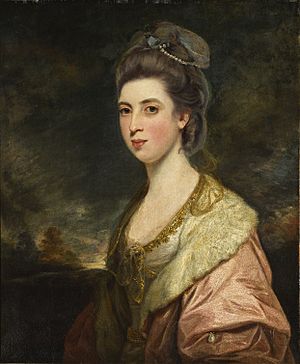Richard Pennant, 1st Baron Penrhyn facts for kids

Richard Pennant, 1st Baron Penrhyn (born 1737 – died 21 January 1808), was a Welsh politician and a nobleman. He was a Member of Parliament (MP) in the British Parliament. He represented the areas of Petersfield and Liverpool. He served for 29 years between 1761 and 1790. Pennant owned Penrhyn Castle, a large estate near Bangor in North Wales.
Pennant also owned six sugar plantations in Jamaica. These plantations used the forced labour of many enslaved people. In Parliament, Pennant strongly supported the slave trade. He was against the movement to end slavery. In Wales, Pennant played a big part in growing the Welsh slate industry. In 1783, King George III gave him an Irish noble title. He died in 1808. His estates were left to George Hay Dawkins.
Contents
Early Life and Education
Richard Pennant was the second son of John Pennant. His father was a merchant from Liverpool. His mother, Bonella Hodges, was a rich heiress from the British colony of Jamaica. Richard went to school at Newcome's School in Hackney. He then attended Trinity College, Cambridge starting in 1754.
Richard Pennant's Political Career

Pennant became an MP in the House of Commons in 1761. He represented Petersfield. Later, he wanted to represent Liverpool. In 1767, he became the MP for Liverpool without anyone opposing him. He won elections in Liverpool again in 1768 and 1774.
In 1780, he lost the election in Liverpool. But in 1783, King George III gave him an Irish noble title. He became the 1st Baron Penrhyn. Having an Irish noble title did not stop him from being an MP. This was because Irish nobles could serve in the House of Commons.
In 1784, Penrhyn ran for Liverpool again and won. During this time, he gave many speeches about the West Indies and trade in Liverpool. In May 1788, there was a debate about the slave trade. Reports say that only two MPs spoke in favor of the trade. These were Penrhyn and Bamber Gascoyne. He ran for Liverpool again in 1790. He was ahead in the votes but stepped aside for Sir Banastre Tarleton. Tarleton also strongly supported the slave trade.
Estates and the Slate Industry
Pennant owned many properties in Caernarfonshire, Wales. He inherited half of them from his wife, Ann Susannah Pennant. She was the daughter of a British Army officer. He inherited the other half from his father. His father was a business partner of his wife's father.
As the owner of Penrhyn quarry, Pennant was very important in developing the Welsh slate industry. He also owned six sugar plantations in Jamaica. These plantations used the forced labour of over six hundred enslaved African people. Pennant never visited Jamaica. He managed his plantations from Britain. The money he earned from these plantations was used to build roads and docks. He also invested in the Welsh slate industry, especially the Penrhyn quarry.
Death and Legacy
Richard Pennant died on 21 January 1808. His entire estate went to his second cousin, George Hay Dawkins. George then took the last name Dawkins-Pennant. George's daughter, Juliana, and her husband were named as co-heirs. They also had to take the last name Pennant, which they did. Juliana's husband, Edward Gordon Douglas, later became the 1st Baron Penrhyn of Llandygai. Lady Penrhyn, Richard's wife, moved to a home in Grosvenor Square after his death.

